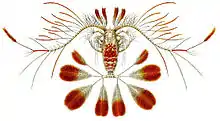Paracalanidae
Paracalanidae is a family of Calanoid copepods, consisting of the following genera:[2]
- Acrocalanus Giesbrecht, 1888
- Bestiolina Andronov, 1991
- Delibus Vives & Shmelava, 2007
- Paracalanus Boeck, 1865
- Parvocalanus Andronov, 1970
- Pseudoparacalanus Robinson, 1948
| Paracalanidae | |
|---|---|
 | |
| Calocalanus pavo | |
| Scientific classification | |
| Kingdom: | |
| Phylum: | |
| Subphylum: | |
| Class: | |
| Subclass: | |
| Order: | |
| Family: | Paracalanidae |
| Genera | |
|
See text | |
Parvocalanus is one of the smallest of the calanoid genera, and P. crassirostris is thought to be the smallest described calanoid (male prosome = 0.7 mm).[3] Two species, P. crassirostris and P. brevispinis, are common. The former is a widely distributed subtropical species that feeds largely on small flagellate phytoplankton. Although a subtropical species might be expected to flourish in summer, external factors such as predation can produce anomalous patterns of abundance. For example, in Long Island Sound the species does not reach its peak of abundance until October, when the disappearance of ctenophores relieves predation pressure [4] P. crassirostris is widely used as fish food in the aquaculture and aquarium industries, being relatively easy to maintain in culture.
References
- "Paracalanidae Giesbrecht, 1893". Integrated Taxonomic Information System. Retrieved August 31, 2011.
- T. Chad Walter & Geoff Boxshall (2011). T. C. Walter & G. Boxshall (ed.). "Paracalanidae". World Copepoda database. World Register of Marine Species. Retrieved August 31, 2011.
- Davis, C.C. 1944. Maryland Board of Natural Resources, Dept. Research Education Publ. No. 61.
- T.D. Johnson. 1987. Growth and regulation of a population of Parvocalanus crassirostris (Copepoda:Calanoida) in Long Island Sound, New York. Ph.D. Diss, SUNY Stony Brook.